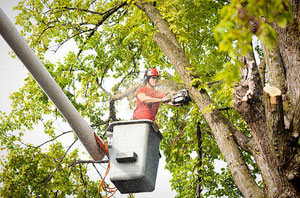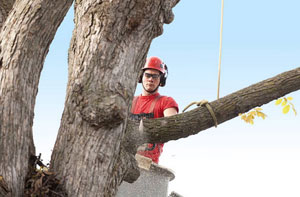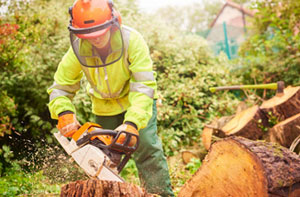Sandown Tree Surgeon Isle of Wight: A vital feature of many gardens and properties in Sandown, trees add structure, style and substance to what can frequently be an unexciting and 2 dimensional area. However, when poorly maintained or affected by severe weather conditions such as flooding or gales, trees can be a bit of an issue. Seeking the expert advice of a trained tree surgeon in Sandown, is the safest option when there is work that needs doing on your trees.
Using an unqualified person for tree work or attempting to do the work by yourself, could harm your trees, cause damage to property, or even lead to injury or death. However, even for professional tree surgeons who are acquainted with all the hazards, tree work is not entirely safe. There are an average of three deaths and 140 major injuries per year within the industry, making it one of the most dangerous jobs in the United Kingdom and certainly not for novices to attempt.

With around five people annually being tragically killed by falling branches and trees in the UK, even a neglected or damaged tree can also pose a danger to life. You might be liable for any compensation to a third-party due to the consequences of your actions, if you bring in someone to carry out tree work and an injury occurs, or property is damaged. These reasons are why it is essential to hire a certified tree surgeon to undertake the work on your trees in Sandown. (Figures sourced from HSE).
A decent Sandown tree surgeon will likely be a signed up member of one or both of the 2 principal professional industry bodies. The membership and professional standing of any tree surgeon in Sandown can be checked out on the websites of both the Arboricultural Association and the International Society of Arboriculture. To find out if any particular tree surgeon has recognised Approved ARB Contractor status and has membership of either of these two associations, you can check this page.
If there is a problem during the course of the work, or after it's been concluded you'll be able to get in touch with these trade organisations for mediation assistance and for guidance and help.

If someone offers to provide you with an estimate for any tree work and you cannot find them on this directory, you should courteously decline their offer of work and carry on with your search for an approved contractor. You should try and get a minimum of 3 different price quotes from various companies in Sandown when you've reassured yourself of their professional memberships and accreditations. You should ask the following questions while acquiring the quotations, making it clear that you need the answers because of the risks involved in the work:
- Can you provide documents to show that you've got the appropriate qualifications, membership of the ISA or AA, and also a certificate for chainsaw use from the NPTC/LANTRA? It is required by law that any tree worker who uses a chainsaw must have a NPTC/LANTRA certificate. Qualifications might include National Diplomas and Certificates in Arboriculture.
- Is It Possible To contact a recent person you have worked for so I can check the standard of your work? Doing an independent examination of any recent work is always advisable.
- Can you provide a written quotation? Only ever accept a quote in writing. NEVER accept a verbal quote only.
- How much insurance cover do you provide? Your tree surgeon should be able to show you an insurance certificate covering a minimum of five million pounds public liability, as recommended by the AA and ISA.
Clear and precise details about all the tree work that is being undertaken should be included on the written quote. It should indicate whose responsibility it is to remove debris, tree branches and stumps, and should also include details about any trees which may be protected in law, and the steps required to obtain permission to work on them. You should also make sure VAT has been included on the quotation. Realising that you've got a responsibility to employ only capable tradespeople to work on your trees and property, is very important.
PRIOR TO WORK - Finding out whether any of your trees are covered by a a TPO (tree protection order), your selected Sandown tree surgeon should make certain that any work can get the go-ahead from the appropriate local authority. Finding that a tree has protected status does not mean that work can't be carried out, because even protected trees require maintenance so as to cut back old or damaged wood and ensure public safety.
If your property in Sandown happens to be in a conservation area, the Local Planning Authority (LPA) will require a minimum of 6 weeks written notice of any tree work you're planning to do. However, tree stems of under seventy five millimetres in diameter when measured at 1.5 metres above the ground are exempt from this requirement. If the branches of a protected tree need to be pruned or thinned to sustain and encourage growth, it is also not necessary to give notice.

On site they'll perform a complete assessment of your trees and determine the necessary remedial treatment and how the required outcome can be achieved with safety in mind. This involves carrying out a risk assessment to include your property, public spaces and any part of a neighbour's property that could be impacted by falling branches. At this point, the quantity of workers needed and the level of protection required will also be established. This is both personal protective equipment (PPE) together with other safety measures to keep the public and other property safe from harm or damage.
ON THE DAY OF WORK - Barriers, cones and safety measures will be put in place before any climbing, tree felling or cutting of branches commences, to keep passers-by and unauthorised persons away from the area of work. It may at some point be necessary to stop the traffic momentarily, if there's a threat of debris and branches falling onto the highway.
Dependent on the kind of work that is required a tree surgeon will need different degrees of protection. When doing chainsaw work, they will as a bare minimum be wearing protective clothing to avoid cutting injuries to the hands, torso and legs. All workers involved in the operation should be wearing head and eye protection, and hi-vis clothing, at all times.
Additional staff will generally be necessary to help with the safe removal of high branches and pieces of tree trunk, especially if working at height is involved, and where ladders and associated climbing equipment is being deployed. It is a good idea to inform your next door neighbours of the need for easy access, since a vehicle or skip for removing the waste will be parked as close to the work area as possible.
UPON COMPLETION OF WORK - All of the waste materials will be hauled away and the site cleared of all debris, after all the tree work has been completed. Your tree surgeon should then sign off and give you a certificate of work, especially where the trees are under a protection order. If any safety measures were put in public areas they can now be taken down, with roads and paths being re-opened.
If you have any complaints about the completed work, you should get them fixed immediately by firstly speaking to the tree surgeon. If your tree surgeon is a member of a professional trade association, you can get help and guidance from the AA or the ISA so as to reach a satisfactory solution, if any further arbitration is required.
Local Sandown tree surgeons will probably have the telephone dialling code 01983 and the postcode PO36. They will work in Sandown itself, along with nearby areas like Yaverland, Luccombe, Adgestone, Merstone, Godshill, Brading, Lake, Alverstone, Ventnor, Winford, Wroxall, Arreton, Shanklin, Whiteley Bank, Newchurch, Queens Bower, Ninham, Apse Heath, and these postcodes: PO36 8JG, PO36 8QE, PO36, PO36 8LJ, PO36 8NA, PO36 8AX, PO36 8HP, PO36 8AD, PO36 8BP, PO36 0AA.
For this type of assistance it is certainly best to use a reputable tree surgeon. Sandown homeowners can greatly benefit from the skills and expertise that a fully trained professional can offer.
The ISA - International Society of Arboriculture
Having its headquarters in Georgia, USA, the International Society of Arboriculture, normally referred to as simply the ISA is a non-profit organisation that encourages the awareness and benefits of trees. A membership association that serves the tree care industry all around the world, the ISA champions the professional practice of arboriculture.
Endorsing best tree care practices via educational events, publications and services, the ISA has a firm focus on enabling individuals in the tree care sector develop their knowledge, arboricultural expertise and skills whenever possible.
The Arboricultural Association was accepted as an associate organisation of the ISA after signing a 2016 agreement with them. This allowed the two bodies to strengthen their relationship, whilst offering further opportunities for anybody in the UK and Ireland who's a signed-up member of the ISA. AA members in the UK and Ireland now benefit from being part of a network of tree care professionals from around the globe. The ISA now has professional affiliates and associate organisations in EXTRAlandscaping, arboriculture, crown thinning Sandown, shrub maintenance, stump grinding, hedge cutting in Sandown, tree maintenance Sandown, tree surveys Sandown, forestry management in Sandown, tree cutting, residential tree care Sandown, site clearance, airspading, tree waste removal, hazard assessments, damaged tree cutting and removal, tree transplanting Sandown, terravention Sandown, damage restoration, the protection of trees from grazing, staking, stump treatment, tree lopping in Sandown, pest management, crown cleaning, hedge lowering, crown lifting, commercial tree care, stump removal in Sandown, emergency tree removalTEN, and the UK, and has an international membership of over 22,000.
Skills Needed to be Tree Surgeons in Sandown
- Have the ability to work well with your hands.
- To be thorough and pay close attention to detail.
- To be able to carry out basic tasks on a hand-held device or computer.
- Have patience and the ability to stay calm and focused in times of stress.
- Have good customer service skills.
- Physical skills such as co-ordination and movement.
- Be alert to the complexities and dangers involved with the various aspects of tree work.
- Have the ability to repair, use and maintain tools and equipment.
- Be professional and capable of completing work within the set timeframe.
- Have the ability to work successfully others.
- Have a good understanding of public safety.
Tree Removal Sandown

Although there could be various reasons behind why you may want to take out a tree from your property or garden in Sandown, tree removal should actually be a last resort. A lot of trees could even be protected by law, therefore you can't take them out even if you wanted to, unless of course they're a safety threat. Authentic factors behind tree removal could be if the roots are obstructing retaining walls/foundations, your tree is hampering a new construction project, the tree is just too large for its setting, you have a dead/dying tree, the tree is infected/diseased, your tree poses a hazard to safety or your tree has been uprooted by the weather. (Tags: Tree Removal Sandown, Removing Trees Sandown, Tree Felling Sandown)
Wood Chipping Sandown

In order to process the large quantities of branches, tree limbs and vegetation that result from their work, the majority of Sandown tree surgeons will make use of wood chipping machinery. These impressive wood chipping systems can gobble up as much as 40 tons of material every hour, depending on what equipment is being used, though the most commonly used devices will process around five tonnes every hour.
Having lots of uses such as garden pathways, cultivating mushrooms, ecosystem restoration, mulch in gardening, weed prevention, biomass solid fuel, landscaping and wood pulp, the chopped down timber is also far easier to transport.
The majority of tree surgeons in Sandown will be prepared to let you keep the wood chips that are produced during the tree work, if you've a good use for them, if not they will generally dispose of them or use them on other landscaping projects. Whether or not you need any tree surgery doing, you will appreciate that tree surgeons are a great source for wood chippings that you can use in your garden in Sandown. Certain tree surgeons will charge you for wood chips, particularly if you need them to be delivered, others will let you have them for nothing.
Companies like Hyundai, Forest Master, Forst and Timberwolf, make some of the best know wood chipping machines that are used in Sandown.
Dead-Wooding Sandown
The process of dead-wooding (or deadwooding) is a crucial part of tree care in Sandown, and any professional tree surgeon will be able to offer you this service. Involving the careful removal or dead and dying branches which could present a threat to homes, vehicles or passers-by, dead-wooding can help make a tree both safer and healthier. The most commonplace reasons for the branches of a tree dying are attack by pests, disease, heavy shading or damaged roots, and this is of course a completely natural process.
Whilst the purpose of safety is the most frequent reason for removing dead branches, the procedure can also be carried out for aesthetic reasons and for the overall benefit of the tree. A tree which has an excessive amount of dying, dead and damaged branches is susceptible to insect infestation and disease, so you can greatly improve the health of a tree by removing these impaired branches. Dead and decaying wood also makes a tree look ugly, and by removing much of this you can make it more attractive.
Only larger dead branches will be cut and removed in many instances, because a minimal risk is posed by the smaller ones. However, it may be necessary to cut out and remove any dead wood that is in excess of 50mm in diameter, where trees in Sandown hang over a highway, a park, a public area, a garden or a property.
Protecting Trees and Shrubs in the Wintertime
Although the winter conditions are seldom harsh enough to justify protecting your trees and shrubs, it is definitely worth looking at as a precaution. In fact, even plants, shrubs and trees that we normally consider to be hardy, will benefit from some additional protection in the cooler winter months.
Although most of your trees will have already shed their leaves by winter in Sandown, it is storms and strong winds that are the biggest worry, and although they offer less wind resistance, they may still be damaged. If you're concerned about the condition of a tree, or it seems like it might fall to the ground, you must speak to a local tree surgeon to inspect it and conduct a risk assessment. Damage to trees can also result from heavy snowfall, so when this sort of weather is on the cards, be on the lookout for issues. Protection from frost and ice may be required for some trees and shrubs (in particular ones that have been newly planted), and a deep covering of mulch around their bases can help to keep their roots from freezing, and allow them to continue absorbing moisture.
Pollarding Trees Sandown

The technique whereby the size of a tree is greatly decreased because it's gotten too big for its existing environment, is know as "pollarding". It can on occasion be employed for aesthetic or functional motives to mould a tree into a specific form or shape. Trees that grow beside roads in Sandown are often pollarded, as are those that are used for borders and in hedgerows. The rather bare and harsh appearance that is the outcome of pollarding isn't at all popular with those who adore trees, as it is so dissimilar to its attractive natural state. The positive aspect of pollarding, is that trees which might otherwise have to be chopped down can be saved. Pollarding is typically used on broad-leafed species like limes, planes, sycamores, oaks, maples, beeches and horse chestnuts.
Tree Surveys Sandown
Tree surveys may be needed for various reasons, but most commonly where property extension or development is concerned. If you're clearing some land in Sandown that has trees on it, to prepare for the building of a new house or an extension to an existing property, you will need to organise a tree survey as laid out by the British Standards BS5837. Sandown tree surveys on both public and private property, must be completed by a certified tree surgeon or arboricultural surveyor.
A broad range of information will be produced about all of the trees within the area specified. For instance:
- The species of trees on the site (either scientific or common).
- The allocation of a tree reference number for every tree.
- The expected lifespan of the trees.
- The existence of any TPOs.
- The diameter of each tree (taken 1.5m above the ground).
- The spread of branches to North, East, West and South.
- The age of the trees (i.e. young, semi-mature, mature, over-mature and veteran).
- The physiological and structural health of the trees.
- The number of trees (those of more than 75mm diameter 1.5m from the ground).
- Tree management recommendations.
- The height of each tree.
If you happen to be carrying out work on an existing home or property in Sandown, but aren't shifting the access points or service lines, or increasing the footprint of the building, you will probably not need to do a tree survey. (Tags: Sandown Tree Surveys, Tree Surveys Sandown, Tree Surveyors Sandown, Tree Survey Sandown).
Ash Dieback (Hymenoscyphus Fraxineus)
A harmful fungal disease that's expected to decimate around 80 percent of the current British ash trees, over the coming years, ash dieback (Hymenoscyphus fraxineus) was first recorded in the United Kingdom in 2012, when a nursery brought in a number of trees from Holland. Set to have a huge impact on our countryside, ash dieback is probably going to be just as damaging as the previous epidemic of Dutch Elm Disease (DED).
Trees of the Fraxinus genus are affected by this lethal disease, which has an especially disastrous effect on the common ash (Fraxinus excelsior), which is the native British species. Originating in Asia where the native Chinese ash (Fraxinus chinensis) and Manchurian ash (Fraxinus mandshurica) are less seriously affected by it, the fungus which causes ash dieback is known as Hymenoscyphus fraxineus (H. fraxineus), and it kills the tree by obstructing its water transport systems.
Swiftly spread by minute spores which can be blown for miles on the wind, ash dieback (or chalara ash dieback) has become established in most areas of Great Britain with up to eighty five percent mortality rates.
Ash dieback strikes trees of all ages and has symptoms such as:
- Dark brown necrotic lesions form where branches meet with the trunk.
- Foliage that wilts, turns black and falls early.
- New epicormic growth appearing from buds that were dormant previously.
- Leaves that develop dark patches during the summertime.
- Dying shoots and leaves are visible in summer.
Ash trees are able to fight off the disease to some extent, but eventually succumb to continual attacks, year-after-year. There is presently no cure for chalara ash dieback, and no apparent strategy for stopping it spreading.
If you think you have discovered a case of ash dieback on your property in Sandown, or in the local neighbourhood, you can report it to the Forestry Commission's "Tree Alert Service", although the disease is so commonplace all over Great Britain that they're really only interested to know about cases discovered in locations not previously affected. You should however speak to a local tree surgeon, who can offer advice and guidance on how to proceed.
Trees that are affected by ash dieback: Fraxinus excelsior, EXTRAlandscaping, arboriculture, crown thinning Sandown, shrub maintenance, stump grinding, hedge cutting in Sandown, tree maintenance Sandown, tree surveys Sandown, forestry management in Sandown, tree cutting, residential tree care Sandown, site clearance, airspading, tree waste removal, hazard assessments, damaged tree cutting and removal, tree transplanting Sandown, terravention Sandown, damage restoration, the protection of trees from grazing, staking, stump treatment, tree lopping in Sandown, pest management, crown cleaning, hedge lowering, crown lifting, commercial tree care, stump removal in Sandown, emergency tree removalNINE.
Storm Damaged Trees Sandown
Of all the things that grow in our garden, trees appear to be the strongest, sturdiest and the most able to survive the vagaries of Mother Nature. Certain types of trees can in fact live for several hundred years and will happily do so in most situations.
Severe weather can however cause extensive damage to trees, and besides the ever present danger of falling tree limbs and branches, trees can even fall down completely in certain situations. Trees have got one main weather related enemy, and that is high winds. As extreme weather events and violent storms become more commonplace with climate change, this type of damage will happen with greater frequency in Sandown. Floods or prolonged periods of rain can cause soil to become waterlogged, which can cause further problems for trees, as can heavy snow in the winter.
To trim and remove any dead, dying or excessively long branches that might cause an issue in times of severe weather, it's a good idea to get a competent Sandown tree surgeon to check out your trees fairly regularly.
It's also important to fit bigger trees with copper conductors, lightning rods, or other protection systems, to prevent them getting struck by lightning, and to protect nearby buildings and property which could be susceptible to "jumps" or side-flashes. Trees can be damaged, seriously weakened, or even killed by lightning strikes, they can be split down the middle, burned to the ground, or left vulnerable to decay, pests or disease - not the happiest of situations! Whilst you might not believe that lightning is that common in Sandown, each year around 300,000 strikes occur throughout the UK.
If you are concerned about the risk of your trees in Sandown being damaged by storms, you should ask your local tree surgery firm what they can do to safeguard them, and lower the risk of mishaps occurring.
Dutch Elm Disease
No longer the problem that it once was, Dutch Elm Disease (Ophiostoma novo-ulmi) has killed many millions of precious elm trees right through the British Isles over the past fifty years or so. Accidentally imported into the United Kingdom, in infected elm logs imported from North America (Canada) in the late nineteen sixties, Dutch Elm Disease is caused by the fungus Ophiostoma novo-ulmi which is spread by the elm bark beetle (especially the Scolytus genus).
Its fast spread was largely down to to elm products such as saplings, mulching bark, crates, and logs with the bark still attached, being transported throughout the British Isles. Dutch Elm Disease did not only affect Britain, but also devastated the stocks of elm trees in mainland Europe and North America, it is thought to have originated in Asia.
Usually first appearing in early summer, the recognisable symptoms of DED disease are:
- Dark spots or rings in the cross-section of twigs.
- Shoots that die back from the tip.
- Clusters of leaves turning yellow, wilting and falling.
- A "shepherd's crook" reaction on affected twigs.
As there are now hardly any sizeable elms in the UK countryside, the beetle's habitat has been largely removed, which has resulted in a slowing of DED. There's currently a continuing project for propagating young trees that are resistant to Dutch Elm Disease.
If you've got elm trees in your garden in Sandown, and suspect that they may be affected by Dutch Elm Disease, get in touch with your local tree surgeon for advice, or put in a request for a diagnosis from the THDAS (Tree Health Diagnostic and Advisory Service).
Tree Surgery Tasks Sandown

Sandown tree surgeons will likely help with landscaping, arboriculture, crown thinning Sandown, shrub maintenance, stump grinding, hedge cutting in Sandown, tree maintenance Sandown, tree surveys Sandown, forestry management in Sandown, tree cutting, residential tree care Sandown, site clearance, airspading, tree waste removal, hazard assessments, damaged tree cutting and removal, tree transplanting Sandown, terravention Sandown, damage restoration, the protection of trees from grazing, staking, stump treatment, tree lopping in Sandown, pest management, crown cleaning, hedge lowering, crown lifting, commercial tree care, stump removal in Sandown, emergency tree removal and other tree surgeon services in Sandown, Isle of Wight. Listed are just an example of the activities that are handled by a local tree surgeon. Sandown providers will be happy to tell you about their entire range of services.
Tree Surgeons Nearby
Also find: Wroxall tree surgeon, Alverstone tree surgeon, Lake tree surgeon, Newchurch tree surgeon, Adgestone tree surgeon, Merstone tree surgeon, Ninham tree surgeon, Queens Bower tree surgeon, Apse Heath tree surgeon, Arreton tree surgeon, Brading tree surgeon, Whiteley Bank tree surgeon, Yaverland tree surgeon, Winford tree surgeon, Luccombe tree surgeon, Godshill tree surgeon and more. Almost all of these towns and areas are covered by tree care companies. Residents in the area can obtain tree surgery price quotes by clicking here.
Tree Care Services Sandown
- Sandown Tree Dismantling
- Sandown Air-Spading
- Sandown Tree Reduction
- Sandown Tree Inspections
- Sandown Crown Reduction
- Sandown Tree Bracing
- Sandown Tree Pruning
- Sandown Tree Pollarding
- Sandown Root Decompaction
- Sandown Tree Removal
- Sandown Crown Lifting
- Sandown Crown Thinning
- Sandown Root Removal
- Sandown Tree Maintenance
 Tree Surgeon Sandown
Tree Surgeon Sandown Tree Care Sandown
Tree Care Sandown Tree Surgery Sandown
Tree Surgery SandownTo get local information relating to Sandown, Isle of Wight take a look here
Tree Surgery PO36 area, phone code 01983.
PO36 - Arboriculturalist Sandown - Tree Management Sandown - Tree Surgery Sandown - Crown Lifting Sandown - Stump Grinding Sandown - Tree Care Sandown - Tree Reshaping Sandown - Tree Removal Sandown





